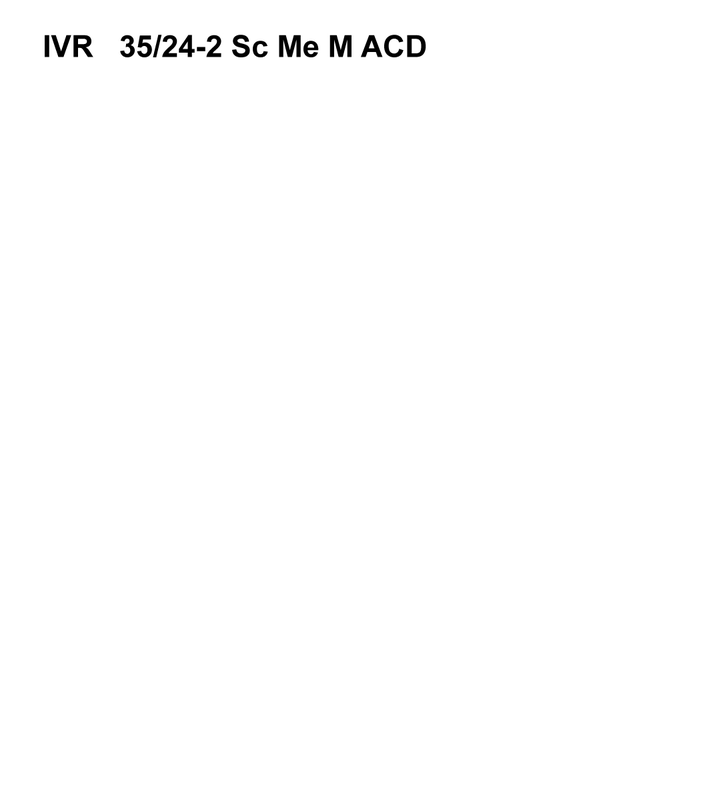
99908180 (01/25)

99908180 (01/25)
Read these original instructions before using your device for the first time, adhere to the instructions contained therein and store them for later reference or subsequent owners.
Be sure to read the safety instructions no. 5.956-249.0 prior to the initial startup.
If the operating instructions and safety instructions are not observed, the device can be damaged and dangers could arise for users and other persons.
Notify the dealer immediately in the case of shipping damage.
Indication of an imminent threat of danger that will lead to severe injuries or even death.
Indication of a potentially dangerous situation that may lead to severe injuries or even death.
Indication of a potentially dangerous situation that may lead to minor injuries.
Indication of a potentially dangerous situation that may lead to damage to property.
Only trained personnel are permitted to use the device and the substances for which it is to be used, including the safe procedure for disposing of the vacuumed material.
An air exchange rate L must be present in the room when the exhaust gas is returned into the room. To remain within the required limit values, the volume flow of returned air must be no greater than 50% of the fresh air volume (room volume VR x air exchange rate LW). Without special ventilation measures, the following applies: LW=1h-1.
This device contains dust that is harmful to your health. Emptying and maintenance, including removal of the dust bag, may only be performed by technical specialists wearing suitable personal protective equipment.
Do not operate the device without the complete filtration system.
Observe the applicable safety instructions for the materials being vacuumed.
The simultaneous collection of different combustible dusts in the collection container can lead to fires or explosion.
You must not set up or operate the device in areas where there is a risk of dust or gas explosion. A dust explosive atmosphere inside the device is only allowed in front of the filter. Gas explosive atmospheres are prohibited inside the device.
The device is not suitable for the suctioning or vacuuming of flammable liquids (flammable, easily flammable, highly flammable according to Dangerous Substances Directive 67/548/EEC) (flash point below 55 °C) and mixtures of flammable dusts and liquids.
The device is not suitable for the vacuuming of dusts with extremely low minimum ignition energy (ME <1 mJ), e.g. toner, mesh, aluminium powder, lead acid suitable.
The device is not suitable for sucking up ignition sources and dusts with a glow temperature ≤ 190 °C.
Every time before use, check whether the equipotential bonding conductors (earthing conductors) are connected.
The device must not be used or stored outdoors in wet conditions.
Apply the parking brake at the steering roller to ensure a secure footing for the device. The device may move uncontrollably if the parking brake is open.
In case of longer breaks in operation and after use, switch off the device at the power switches and unplug the mains plug.
Only use the device indoors.
Risk of crushing! Wear gloves when removing or installing the suction head, filter inlay or collection container.
Risk of damage! Never vacuum without a filter or with a damaged filter.
Wear safety shoes when operating the device.
Only move the device at walking speed, and to move down a decline, have two workers steady the device as necessary.
Be careful to ensure that there is no dust spillage when replacing accessories.
Surface temperatures can rise to 135° C during normal operation.
Avoid kinking the suction hose unit.
Carry out a regular visual inspection of the hoses.
The device may only be connected to an electrical connection which has been set up by a qualified electrician as per IEC 60364. For connected loads seeTechnical data and type plate.
Danger of electric shock
Danger of death
Avoid damaging the power cables by driving over them or otherwise crushing them, or by jerking them.Protect the cables from heat, oil and sharp edges.Check the mains connection of the device for damage every time before operation. Do not operate the device using a damaged cable. Have any damaged cables replaced by a qualified electrician.Risk of injury and damage in the event of a short-circuit or other electrical faults
Danger of electric shock, danger of burns
Switch off the device and unplug the mains plug.Behaviour in case of filter breakage / leakage:
Switch off the unit immediately.
The unit may not be operated without the fresh water filter.
Replace the filter.
The device is intended for:
Wet and dry cleaning of floor and wall surfaces
Vacuuming of dry, flammable, deposited dusts hazardous to health; dust class M according to EN 60335‑2‑69
Vacuuming of non-explosive substances
Vacuuming of flammable dusts of all dust explosion classes (excluding dusts with a minimum ignition energy ME < 1 mJ)
Vacuuming of dusts and coarse dirt
Vacuuming of flammable dusts from a zone 22 if the device is installed outside of potentially explosive areas
Vacuuming moist and liquid substances
Commercial use, e.g.in hotels, schools, hospitals, factories, shops, offices, and rental companies
Industrial usee.g. in storage and production areas
A corresponding Ex device must be used if there is a classified Ex zone at the device installation location.
The device’s correct function is only guaranteed when using suction hose nominal widths of DN40 and DN50.
Any other use constitutes improper use.
The device is not suitable for:
Vacuuming of ignition sources and dusts with a glow temperature ≤ 190 °C
Vacuuming aluminium and magnesium dusts
vacuuming of flammable liquids (flammable, easily flammable, highly flammable according to Dangerous Substances Directive 67/548/EEC) (flash point below 55 °C) and mixtures of flammable dusts and liquids
vacuuming of magnesium dust or powder
vacuuming of mixtures of flammable liquids and flammable dust
Vacuuming of smouldering or hot particles where this could otherwise result in a fire or an explosion
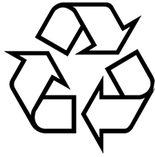 The packing materials can be recycled. Please dispose of packaging in accordance with the environmental regulations.
The packing materials can be recycled. Please dispose of packaging in accordance with the environmental regulations.
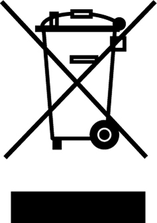 Electrical and electronic devices contain valuable, recyclable materials and often components such as batteries, rechargeable batteries or oil, which - if handled or disposed of incorrectly - can pose a potential danger to human health and the environment. However, these components are required for the correct operation of the device. Devices marked by this symbol are not allowed to be disposed of together with the household rubbish.
Electrical and electronic devices contain valuable, recyclable materials and often components such as batteries, rechargeable batteries or oil, which - if handled or disposed of incorrectly - can pose a potential danger to human health and the environment. However, these components are required for the correct operation of the device. Devices marked by this symbol are not allowed to be disposed of together with the household rubbish.
Current information on content materials can be found at: www.kaercher.de/REACH
Risk of explosion when used with non-permitted accessories
Only use accessories permitted by the manufacturer and with the Ex label for type 22 usage.Only use original accessories and original spare parts. They ensure that the appliance will run safely and fault-free.
Information on accessories and spare parts can be found at www.kaercher.com.
No accessories are included in the scope of delivery. The accessories must be ordered separately depending on the application.
Check the contents for completeness when unpacking. In the event of shipping damage, please notify your dealer.
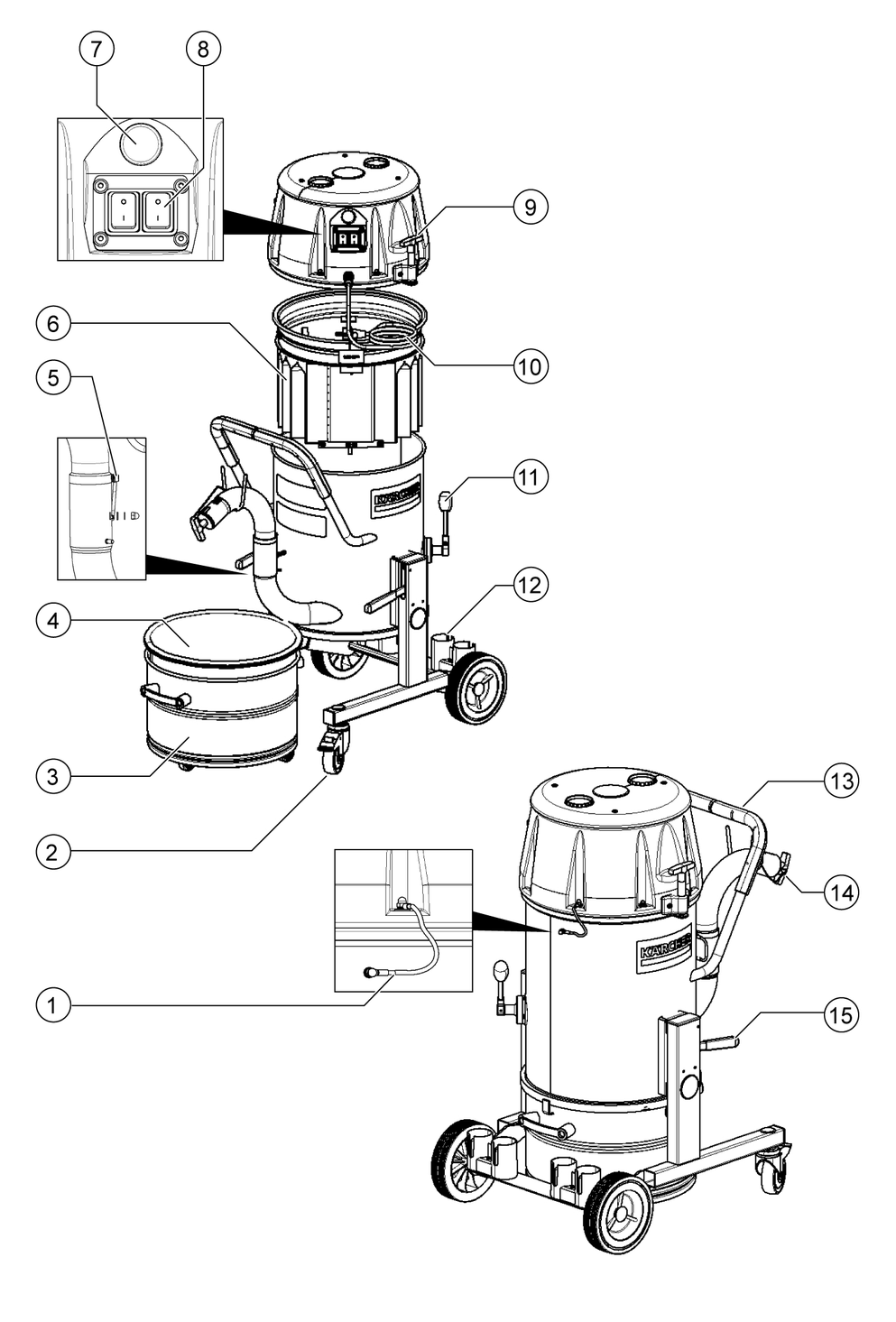
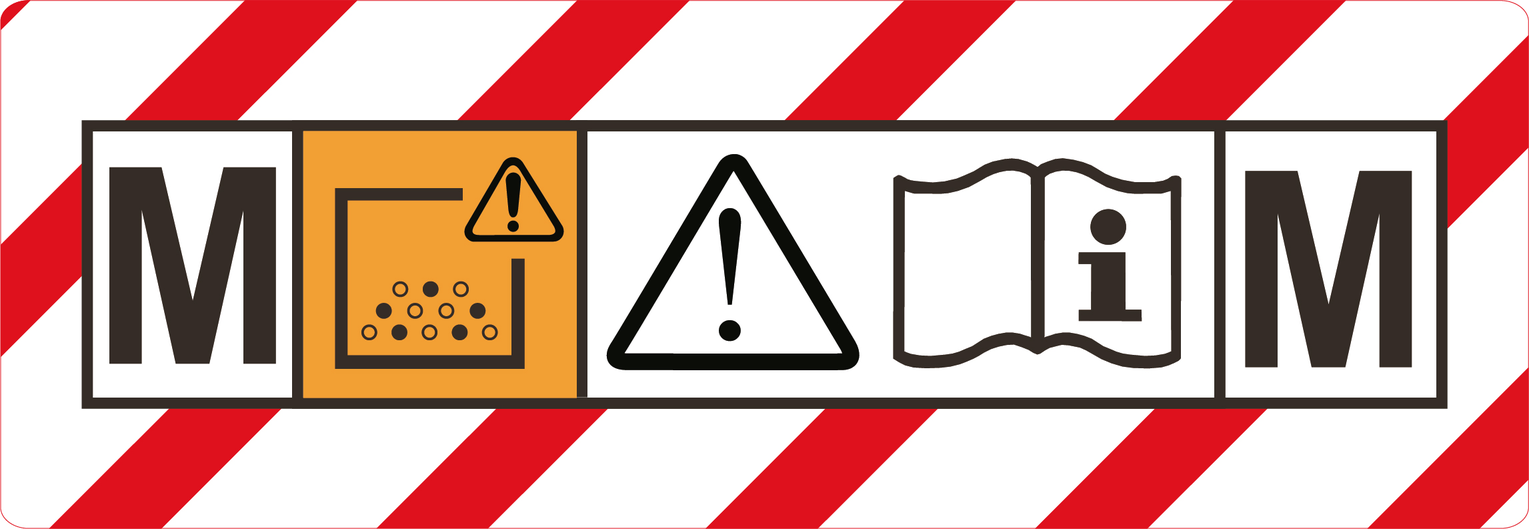
The device is suitable for vacuuming dusts up to dust class M.
Damage to the skin, lungs and eyes
Expulsion of fine dust during emptying and maintenance work and disposal
Wear the prescribed personal protective gear when performing during emptying and maintenance work, including disposal of the dust bag.
The device is suitable for vacuuming flammable dusts, installation outside zone 22.
WARNING: This device must not be placed in any zone 22. If a zone 22 is present, an EX-device must be used.
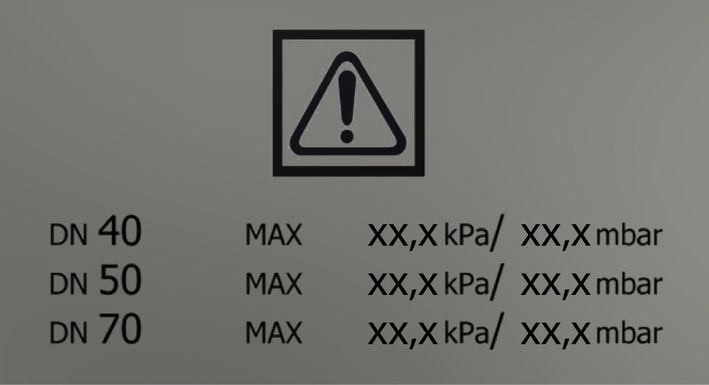
The maximum vacuum value in relation to the hose cross-section is specified on the label. The actual value can be read on the pressure gauge. For the values applicable to this device, see chapter Reading the minimum volumetric flow. If this value is not reached, the filter must be cleaned (see chapter Cleaning the filter) or replaced (see chapter Replacing the filter). The various different hose cross-sections allow adaptation to the various different connection cross-sections of the accessories.
 | Dust bag (Order no. 9.990-890.0) |
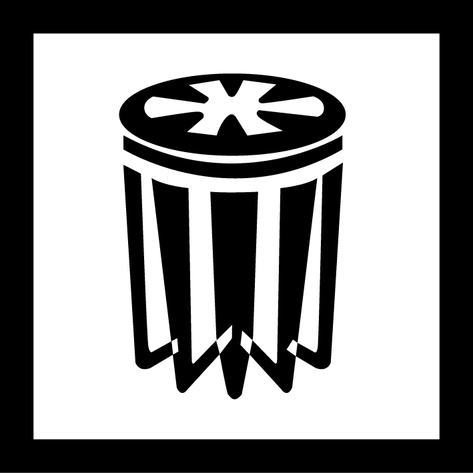 | filter (Order no. 9.980-227.0) |
Potential equalisation line not connected correctly
Electric shock
Every time before use, check whether the equipotential bonding conductor (earthing conductors) are connected.Danger from dust that is harmful to your health
Respiratory sicknesses through inhalation of dust.
Do not vacuum without correctly installed filter elements, otherwise a danger to health from increased fine dust emission is present.Missing filter element
Damage to the suction motor
Do not vacuum without a filter element.Bring the device into the working position.
Secure the device with the parking brakes.
Ensure that the suction head is fitted correctly.
Insert the suction hose (not included in the scope of delivery) into the suction connection.
Check the filling level in the dirt receptacle (see chapter Check the dirt receptacle filling level).
Empty the dirt receptacle if necessary (see chapter Emptying the dirt receptacle).
Fit the dust bag before dry vacuuming (see chapter Fitting the dust bag).
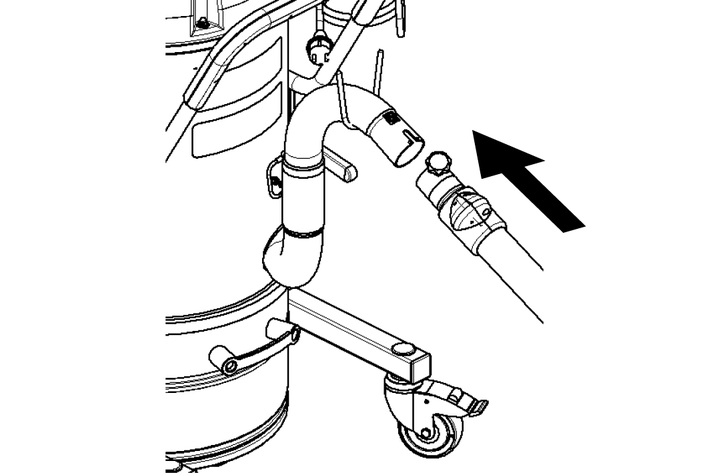
Fit the desired accessory (not included in the scope of delivery) onto the suction hose.
The dirt receptacle must be emptied when it is has filled up to approx. 3 cm below the upper edge.
The device does not switch off automatically when the maximum filling level is exceeded.
Check the dirt receptacle filling level regularly.
The device is suitable for vacuuming fine dust up to dust class M.
Danger from dust that is harmful to your health
Respiratory sicknesses through inhalation of dust.
Do not vacuum without correctly installed filter elements, otherwise a danger to health from increased fine dust emission is present.Danger due to fine dust entering
Risk of damage to the suction motor.
Never remove the filter element when vacuuming.All types of dust up to dust class M can be vacuumed with this device. The use of a dust collection bag is required by law.
The device is an industrial vacuum cleaner for vacuuming dry, flammable dusts.
Switching from wet to dry vacuuming
Risk of damage to the filter
Do not vacuum dry dust with a wet filter element because this clogs the filter and can make it unusable.Allow the wet filter to dry completely or replace it with a dry filter before using the device for dry vacuuming.
Replace the filter if necessary.
Secure the device with the parking brakes.
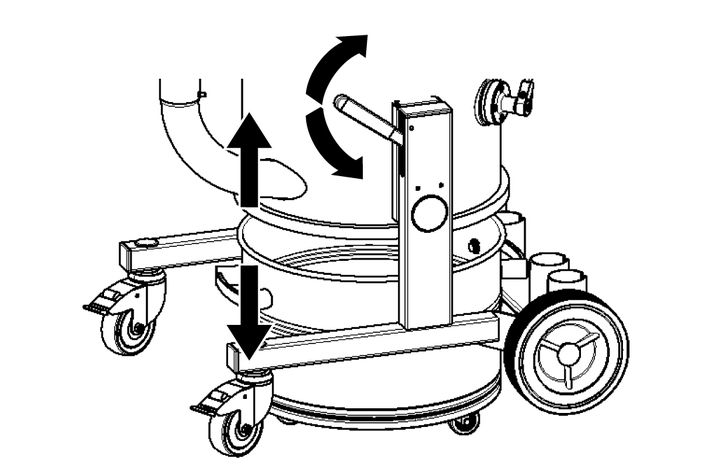
Lower the dirt receptacle by pulling up the lever.
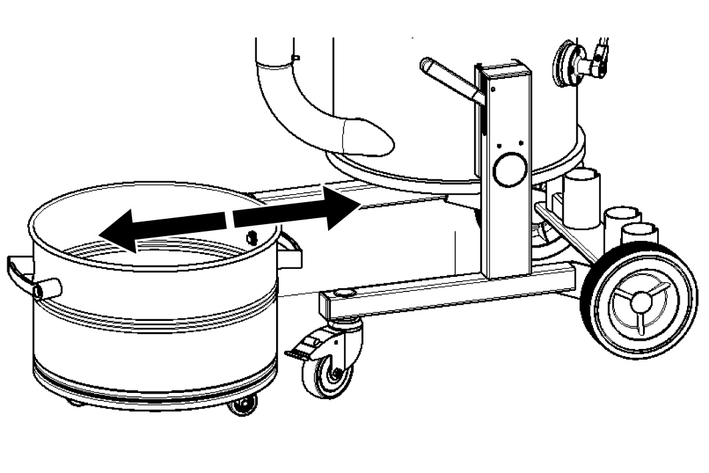
Pull the dirt receptacle out of the device.
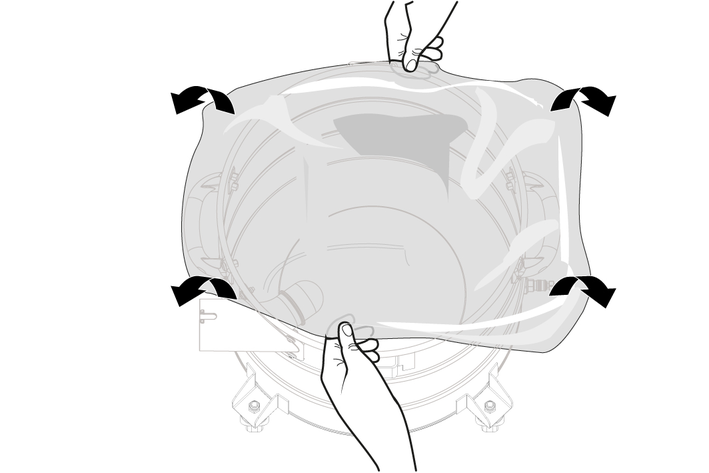
Fit the dust bag in the dirt receptacle and carefully position it against the container wall and the container floor.
Fold the edge of the dust bag over the edge of the dirt receptacle to the outside.

Fit the dirt receptacle in the device.

Improper handling when locking the dirt receptacle
Risk of crushing
Under no circumstances should you hold your hands between the dirt receptacle and filter ring or allow them to come close to the lifting mechanism while locking it.Lock the dirt receptacle by operating the levers with both hands.Static charge of the dirt receptacle
Ignition of dusts
Make sure that the grounding on the chassis is in contact with the dirt receptacle.Lock the dirt receptacle with the levers.
Danger from dust that is harmful to your health
Respiratory sicknesses through inhalation of dust.
No dusts harmful to health may be vacuumed when performing wet vacuum cleaning.Risk of damage if the dirt receptacle overflows
The dirt receptacle can fill within a few seconds and overflow when vacuuming large amounts of liquids.
Continuously monitor the filling level.Remove the dust bag before wet vacuum cleaning (see chapter Removing the dust bag).
Danger from dust that is harmful to your health
Respiratory sicknesses through inhalation of dust.
Accumulated dust must be transported in dust-proof containers. Do not transfer the contents. The dust bag may only be disposed of by qualified staff.Secure the device with the parking brakes.
Remove the suction hose if necessary.
Close the suction connection on the filter ring (see chapter Closing the suction connection).

Lower the dirt receptacle by pulling up the lever.

Pull the dirt receptacle out of the device.
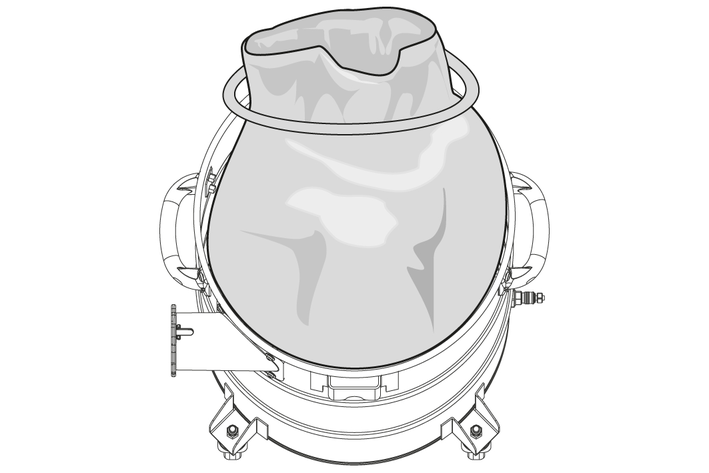
Turn up the dust bag.
Seal the dust bag tightly with the cable tie.
Remove the dust bag.
Dispose of the dust bag in accordance with statutory regulations.

Fit the dirt receptacle in the device.

Improper handling when locking the dirt receptacle
Risk of crushing
Under no circumstances should you hold your hands between the dirt receptacle and filter ring or allow them to come close to the lifting mechanism while locking it.Lock the dirt receptacle by operating the bow handle with both hands.Static charge of the dirt receptacle
Ignition of dusts
Make sure that the grounding on the chassis is in contact with the dirt receptacle.Lock the dirt receptacle with the levers.
Improper disposal of waste water
Environmental pollution
Observe the local waste water treatment regulations.Dry the filter.
Clean the dirt receptacle with a moist cloth and dry it off.
Plug the mains plug into the socket.
Switch on the device via the suction turbine power switches.

Always switch the suction turbines on and off one after the other. For the correct function of the pressure gauge for monitoring the minimum volume flow, all suction turbines must be switched on.
Start the vacuuming process.
A pressure gauge showing the vacuum inside the device is mounted on the front of the device. The filter must be cleaned when the maximum vacuum (see table) is reached (see chapter Cleaning the filter). This value depends on the device performance and the suction hose used. If the vacuum is not significantly reduced by dedusting, the filter must be replaced (see chapter Replacing the filter).
Exceeding the maximum vacuum
Suction loss
If the specified value is exceeded, the air speed in the suction hose drops below 20 m/s. Clean or replace the filter.Hose diameter | Value |
|---|---|
DN40 | 180 mbar (18 kPA) |
DN50 | 160 mbar (16 kPA) |
Clean the filter before or when the specified value is reached.
Clean the filter regularly to avoid declining suction power.
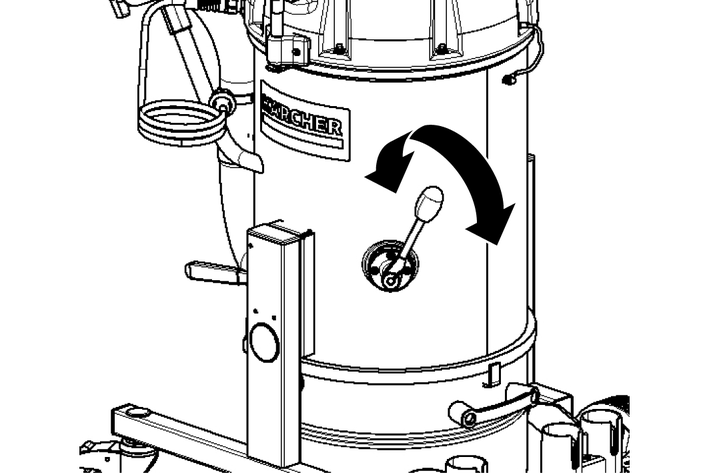
Move the filter cleaning handle back and forth several times to clean the filter.
Switch off the device via the suction turbine power switches.
Pull out the mains plug.
Risk of injury
Damage to the skin, lungs and eyes through fine dust
The suction connection must be closed using the sealing plug after removing the suction hose.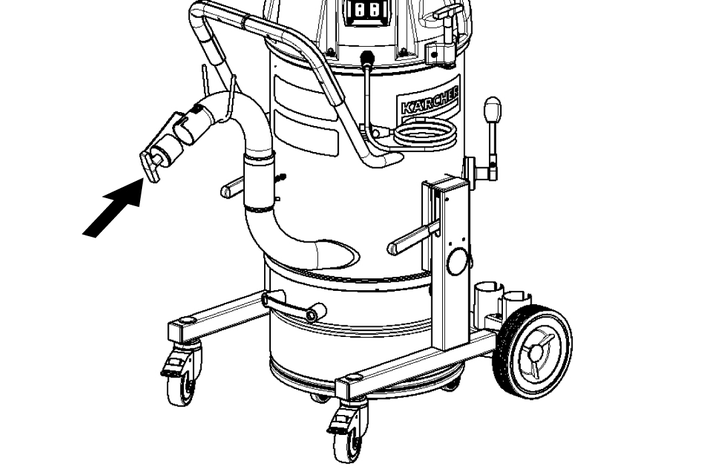
Insert the sealing plug precisely into the suction connection.
Push the sealing plug in all the way to the end stop.
The dirt receptacle must be emptied as required and after each use and cleaned inside and out by vacuuming and wiping with a damp cloth.
A vacuum cleaner with the same or better classification must be used for vacuuming the device.
The inlet opening or the suction hose are closed.
Switch off the device and disconnect from the mains supply.
Clean the filter.
Remove the dirt receptacle from the device and replace the dust bag (see chapter Replacing the dust bag).
Only move the dirt receptacle on its rollers. Do not use a crane, forklift or similar means.
Switch off the device and disconnect it from the mains supply.
Open the suction head lock.

Remove the suction head and put it to one side.
Improper disposal of waste water
Environmental pollution
Observe the local waste water treatment regulations.Vacuum the inside and outside of the device and clean with a moist cloth.
A vacuum cleaner with the same or better classification must be used for vacuuming the device.
If necessary, rinse the accessories (not included in the scope of delivery) with water and dry them.
Wind the mains cable onto the cable holders.
Store the device in a dry room and secure it against unauthorised use.
Failure to observe the weight
Risk of injury and damage
Be aware of the weight of the device during transportation.The dirt receptacle is emptied.
Close the suction connection for dust-free transport (see chapter Closing the suction connection).
Release the parking brakes and push the device by the push handle.
Grasp the device by the chassis and the push handle for loading.
Secure the device against slipping and tipping over when transporting in vehicles.
Failure to observe the weight
Risk of injury and damage
Only store the device on level surfaces to prevent it from tipping over.Be aware of the weight of the device during storage.The dirt receptacle is emptied.
Store the device indoors only.
Inadvertently starting up device, touching live components
Risk of injury, electric shock
Switch off the device before performing any work on the device.Remove the mains plug.Danger from dust that is harmful to your health
Respiratory sicknesses through inhalation of dust.
Wear a breathing protection mask of class P2 or higher and disposable clothing when performing maintenance work (e.g. filter change).Danger from dust that is harmful to your health
Respiratory sicknesses through inhalation of dust.Safety devices providing hazard protection must be checked for correct safety-related functionality at least annually by the manufacturer or an appropriately instruction person, e.g. absence of leaks, filter damage, functionality of the monitoring devices.Care agents containing silicone
These can attach plastic components.
Do not use care agents containing silicone for cleaning.Dust extraction machines are safety devices for the prevention or elimination of hazards according to the DGUV regulation:
For servicing performed by the user, the device must be disassembled, cleaned and maintained only to the degree that this is possible without presenting a danger to the maintenance personnel and other persons. Suitable precautionary measures include detoxification before disassembly. Make provisions for local forced ventilation at the location where the device is to be disassembled, for cleaning the maintenance surface and to ensure adequate protection for the personnel.
The exterior of the device should be detoxified by vacuuming and wiped clean, or treated with sealant before being removed from the hazardous area. All device parts must be regarded as contaminated when they are taken from the hazardous area. Suitable measures must be taken to prevent distribution of the dust.
All contaminated objects resulting from maintenance and repair work that cannot be satisfactorily cleaned must be correctly disposed of. Such objects must be disposed of in sealed bags in accordance with the applicable regulations for the disposal of this type of waste.
The suction hose ports are to be closed using the sealing plugs during transport and maintenance of the device.
Note that you can carry out simple maintenance and care work yourself.
Clean the surface of the device and the interior of the container regularly with a moist cloth.
Carry out a regular visual inspection for clogging of the hoses.
Have the device regularly inspected according to the respective national accident prevention regulations. Maintenance work as specified by the manufacturer must be performed by a technically qualified person at the specified regular intervals and in accordance with the applicable regulations and safety requirements. Work on electrical components may only be performed by a qualified electrician. Please contact a KÄRCHER branch office if you have any questions.
Danger from dust that is harmful to your health
Respiratory sicknesses through inhalation of dust.
Accumulated dust must be transported in dust-proof containers. Do not transfer the contents. The dust bag may only be disposed of by qualified staff.Danger from dust that is harmful to your health
Respiratory sicknesses through inhalation of dust.
Do not use the filter element after removing it from the device.Permanently installed filters may only be replaced in suitable areas, e.g.in so-called decontamination stations) by a technical expert.
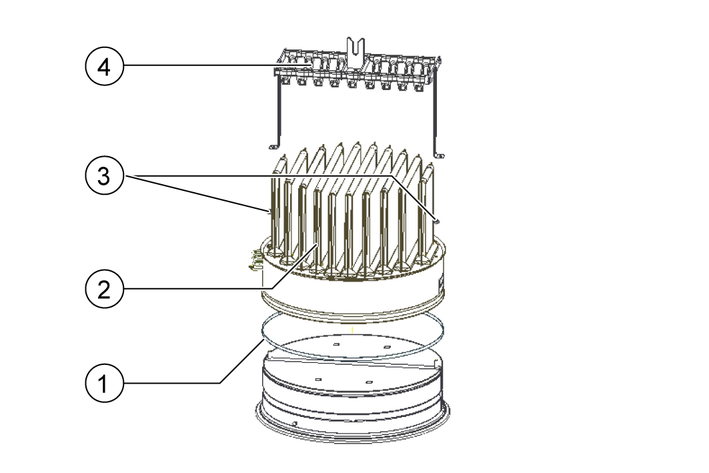
Remove the suction head, see chapter Removing the suction head.
Remove the filter unit from the device using the handles and turn it over.
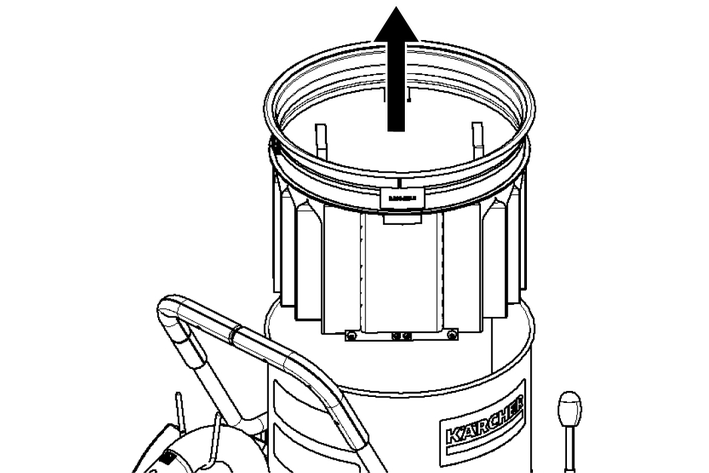
Remove the nuts and remove the cleaning fixture.
Loosen the clamping ring screw connection.
Remove the filter.
Dispose of the foam filter.
Fit a new filter.
Insert the new foam filter.
Fit the tensioning ring and screw it in place.
Fit the cleaning device and screw it on.
Insert the filter inlay.
In doing so, make sure the tab on the filter inlay fits into the shaft.

Danger from dust that is harmful to your health
Respiratory sicknesses through inhalation of dust.
Accumulated dust must be transported in dust-proof containers. Do not transfer the contents. The dust bag may only be disposed of by qualified staff.Secure the device with the parking brakes.
Remove the suction hose if necessary.
Close the suction connection on the filter ring (see chapter Closing the suction connection).

Lower the dirt receptacle by pulling up the lever.

Pull the dirt receptacle out of the device.

Turn up the dust bag.
Seal the dust bag tightly with the cable tie.
Remove the dust bag.
Dispose of the dust bag in accordance with statutory regulations.

Insert the new dust bag in the dirt receptacle and carefully place it against the container wall and the container floor.
Fold the edge of the dust bag over the edge of the dirt receptacle to the outside.

Fit the dirt receptacle in the device.

Improper handling when locking the dirt receptacle
Risk of crushing
Under no circumstances should you hold your hands between the dirt receptacle and filter ring or allow them to come close to the lifting mechanism while locking it.Lock the dirt receptacle by operating the levers with both hands.Static charge of the dirt receptacle
Ignition of dusts
Make sure that the grounding on the chassis is in contact with the dirt receptacle.Lock the dirt receptacle with the levers.
Unintentional start-up of the device / electric shock
Unintentional start-up of the suction motor can cause injuries. Voltage present on electrical parts can cause an electric shock.
Switch off the device and unplug the mains plug before performing any work on the device.Have all checks and work on electrical parts performed by an qualified technician.The device must be switched off immediately in the event of a malfunction. The malfunction must be eliminated before switching the device on again.
If the malfunction cannot be corrected, the device must be checked by the Customer Service department.
Suction turbine does not start up
Remedy:
Check the socket and the power supply fuse.
Check the mains cable and the mains plug of the device.
Switch the device on.
Suction power decreases
Remedy:
Remove the blockages from the suction nozzle, the suction pipe or the suction hose.
Replace the filled dust bag (see chapterReplacing the dust bag).
Check that the suction head and the dirt receptacle are correctly seated.
Dedust the filter (see chapter Cleaning the filter).
Check the seating of the filter and correct if necessary.
Replace the filter (see chapter Replacing the filter).
Escaping dust when vacuuming
Remedy:
Check the seating of the filter and correct if necessary.
Dedust the filter (see chapter Cleaning the filter).
Replace the filter (see chapter Replacing the filter).
At the end of its service life, the device is to be disposed of in accordance with statutory regulations.
The warranty conditions issued by our relevant sales company apply in all countries. We shall remedy possible malfunctions on your appliance within the warranty period free of cost, provided that a material or manufacturing flaw is the cause. In a warranty case, please contact your dealer (with the purchase receipt) or the next authorised customer service site.
Further information can be found at: www.kaercher.com/dealersearch
Further warranty information (if available) can be found in the service area of your local Kärcher website under "Downloads".
Electrical connection | |
Mains voltage | 220-240 V |
Phase | 1 ~ |
Power frequency | 50-60 Hz |
Nominal power | 2400 W |
Protection type | IPX4 |
Protection class | I* |
Dimensions and weights | |
Typical operating weight | 47 kg |
Length x width x height | 720 x 580 x 1090 mm |
Effective filter area | 1,4 m2 |
Ambient conditions | |
Storage temperature | -10-40 °C |
Device performance data | |
Container capacity | 35 l |
Vacuum | 23 (230) kPa (mbar) |
Air quantity | 2 x 74 l/s |
Max. volume flow with suction hose DN50, L=3 m | 250 m3/h |
Max. volume flow with suction hose DN40, L=3 m | 205 m3/h |
Max. volume flow with suction hose DN50, L=5 m | 230 m3/h |
Max. volume flow with suction hose DN40, L=5 m | 190 m3/h |
Suction hose connection | DN50 |
Nominal width of the suction hose | DN40/50 |
Filter order number | 9.980-227.0 |
Determined values in acc. with EN 60335-2-69 | |
Hand-arm vibration value | <2,5 m/s2 |
K uncertainty | 0,2 m/s2 |
Sound pressure level LpA | 67 dB(A) |
Uncertainty KpA | 2 dB(A) |
Mains cable | |
Mains cable H07BQ-F | 3 x 1.5 mm2 |
Part number (EU) | 9.990-835.0 |
Cable length | 10 m |
We hereby declare that the product named below complies with the relevant provisions of the directives and regulations listed. This declaration is invalidated by any changes made to the product that are not approved by us.
Product: Dry vacuum cleaner
Product: Wet/dry vacuum cleaner
Type: 9.990-xxx
Directives and Regulations2006/42/EC (+2009/127/EC)
2014/30/EU
2011/65/EU
Harmonised standards usedEN 60335-1
EN 60335-2-69
EN 55014-1: 2017 + A11: 2020
EN 55014-2: 2015
EN IEC 61000-3-2: 2019
EN 61000-3-11: 2000
EN 62233: 2008
EN IEC 63000: 2018
Non-harmonised standards usedIEC 60335-1
IEC 60335-2-69
Name and addressDocumentation supervisor:
A. Haag
Kärcher Industrial Vacuuming GmbH
Robert-Bosch-Straße 4-8
73550 Waldstetten (Germany)
Tel.: +49 7171 94888-0
Fax: +49 7171 94888-528

Waldstetten, 24/11/01
The signatories act on behalf of and with the authority of the Executive Board.
Kärcher Industrial Vacuuming GmbH
Robert-Bosch-Straße 4-8
73550 Waldstetten (Germany)
Ph.: +49 7171 94888-0
Fax: +49 7171 94888-528
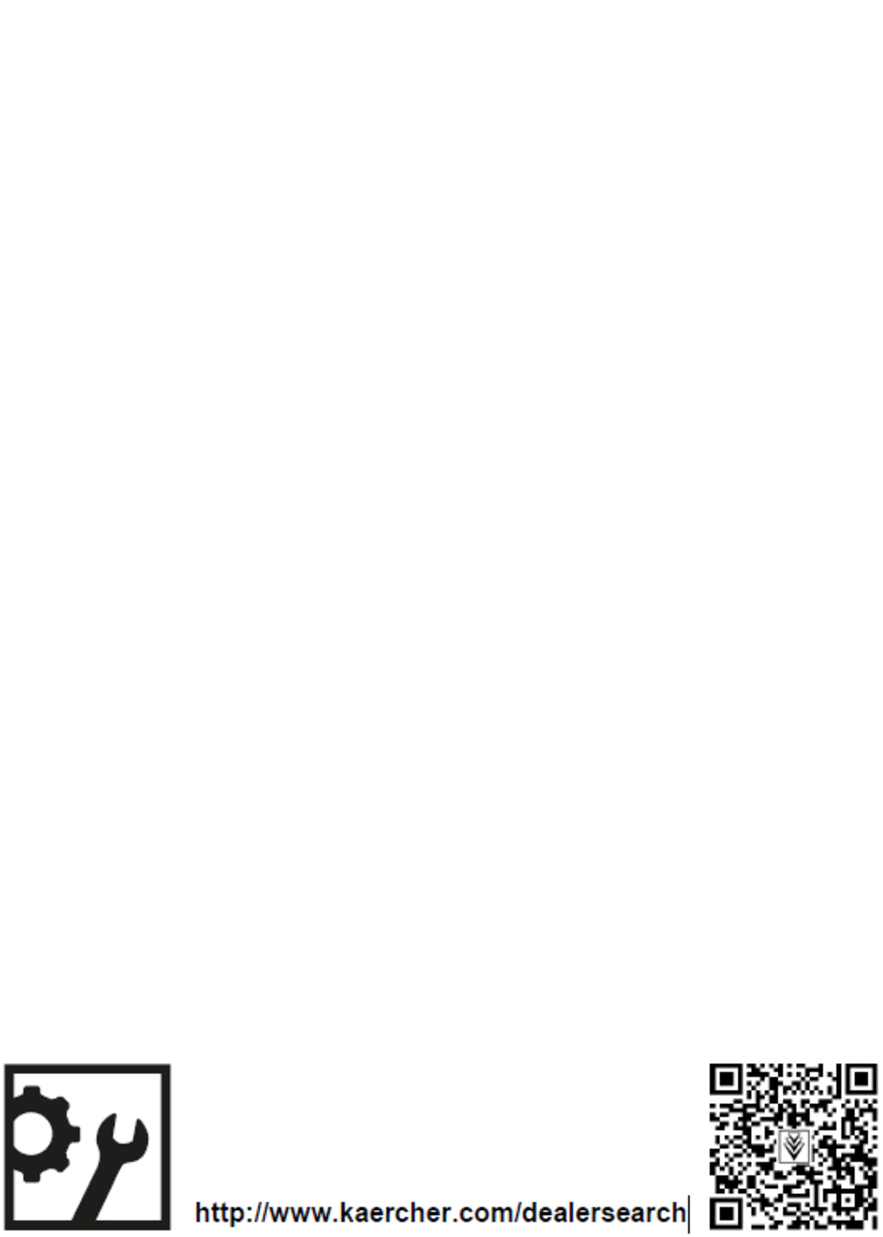
2-2-HC-A5-GS-awx2508